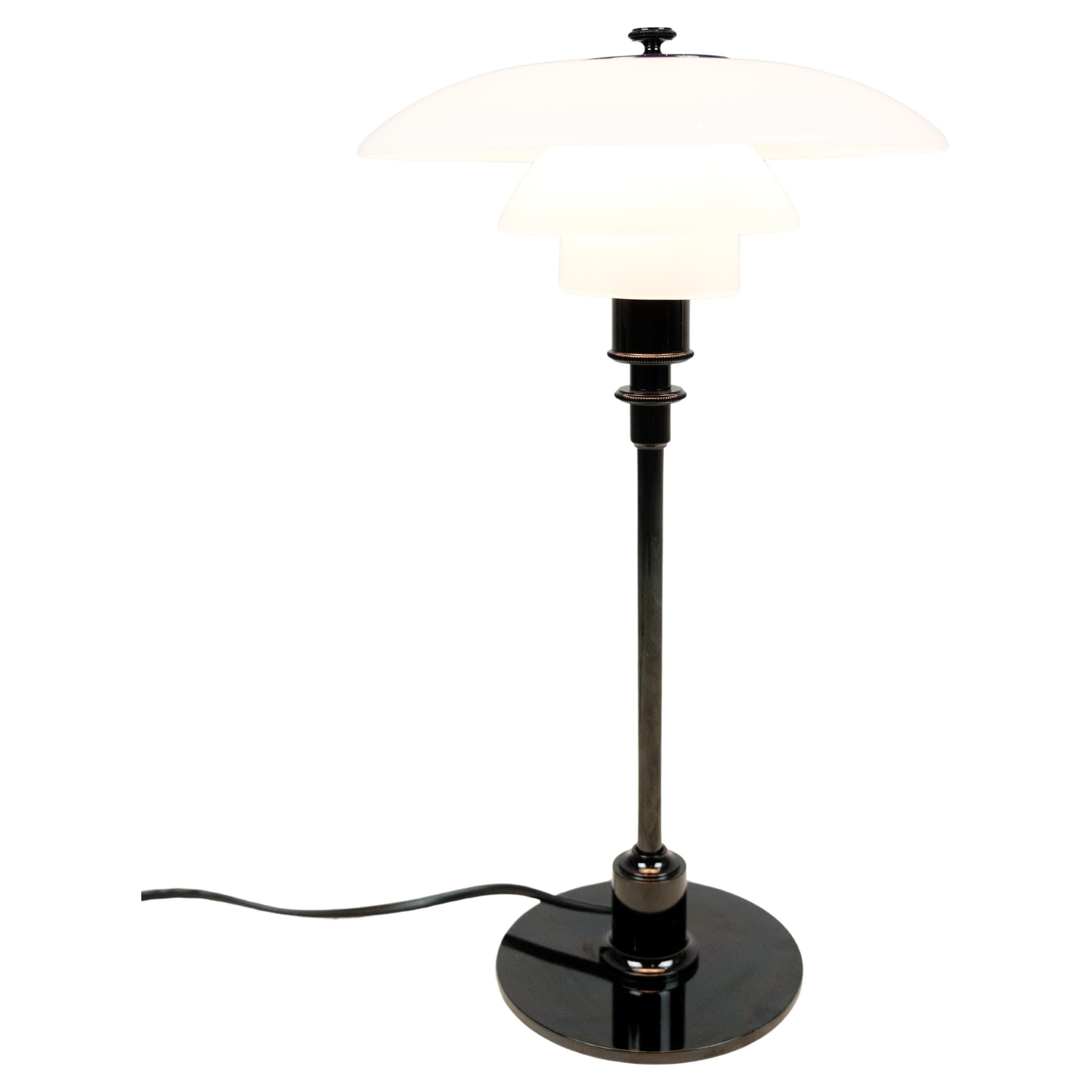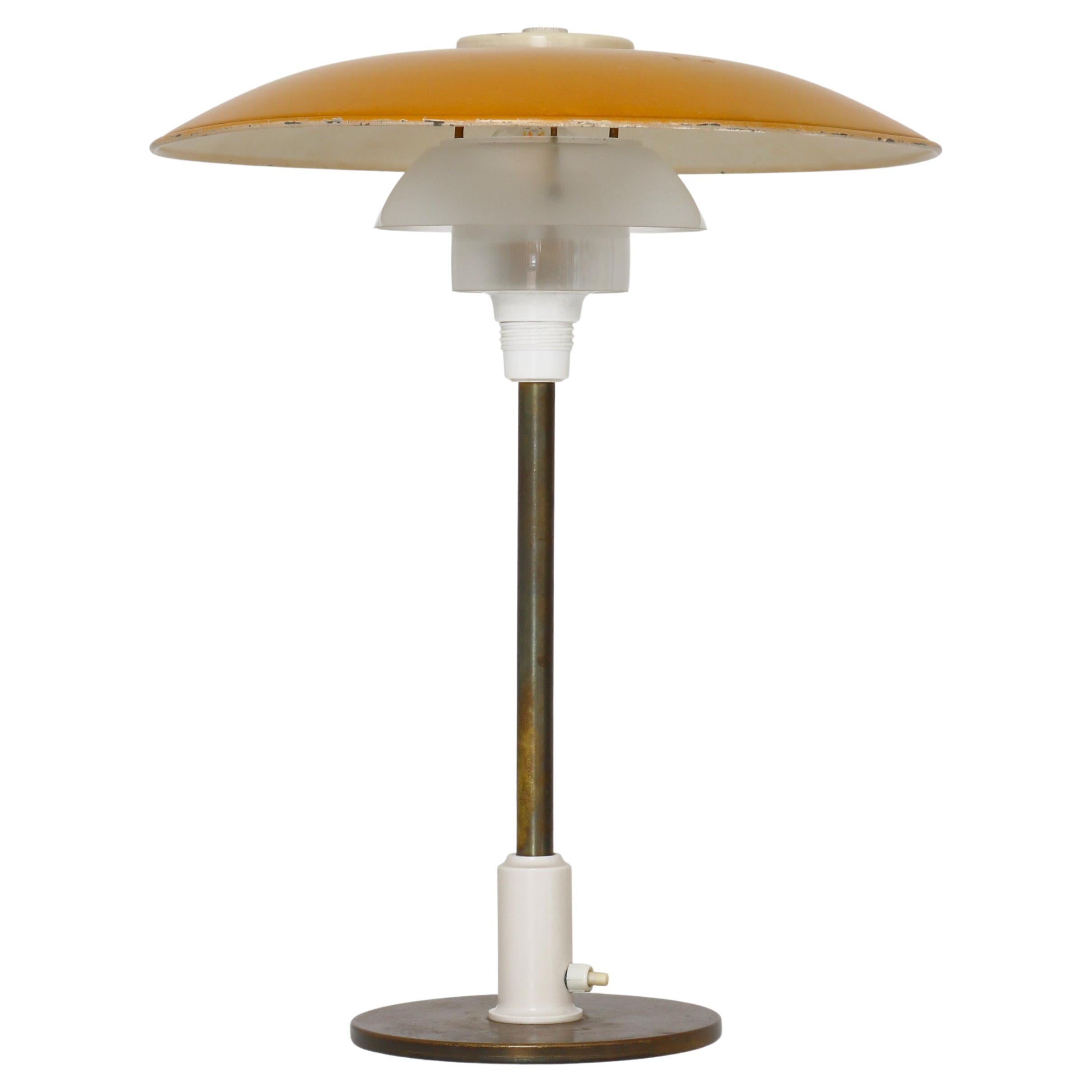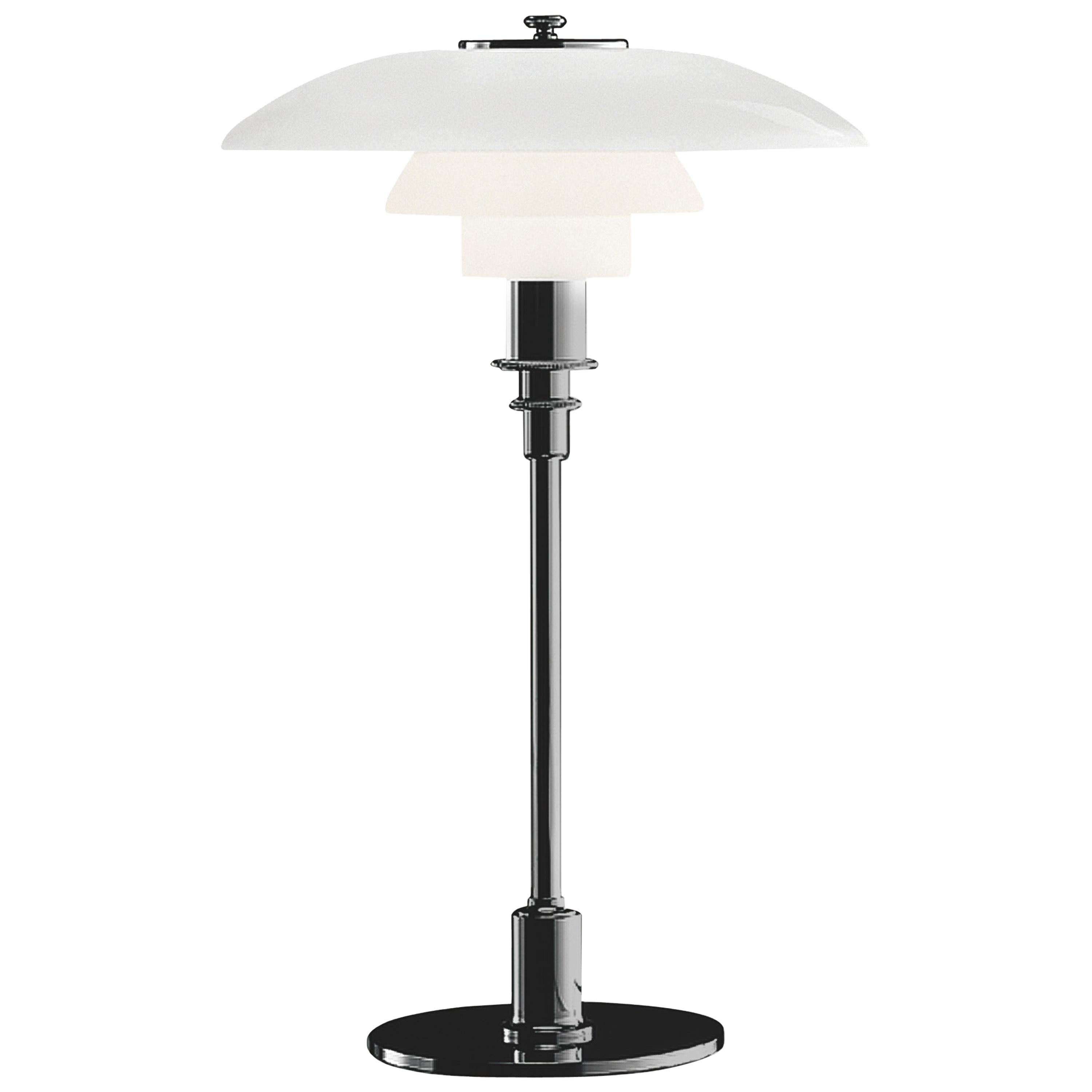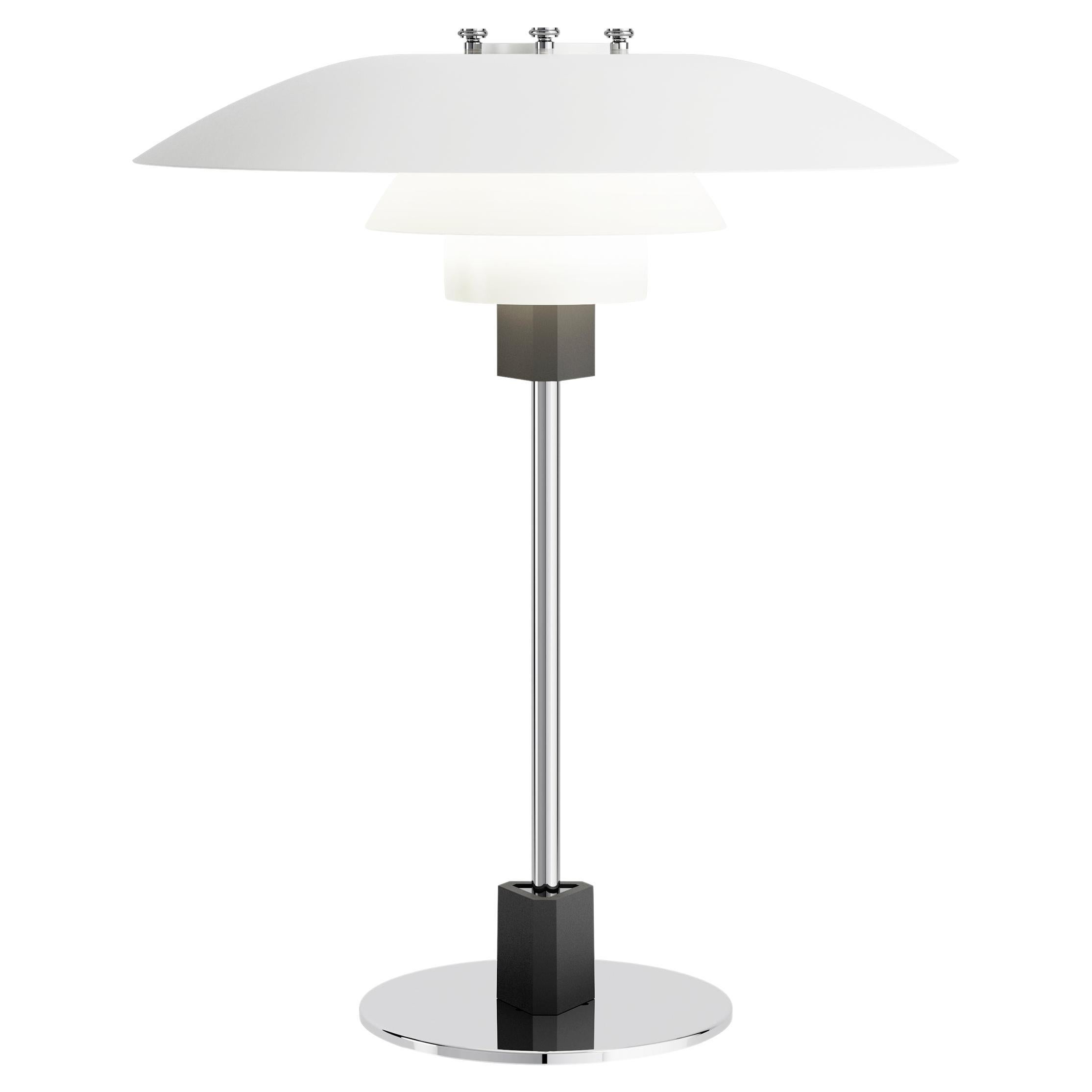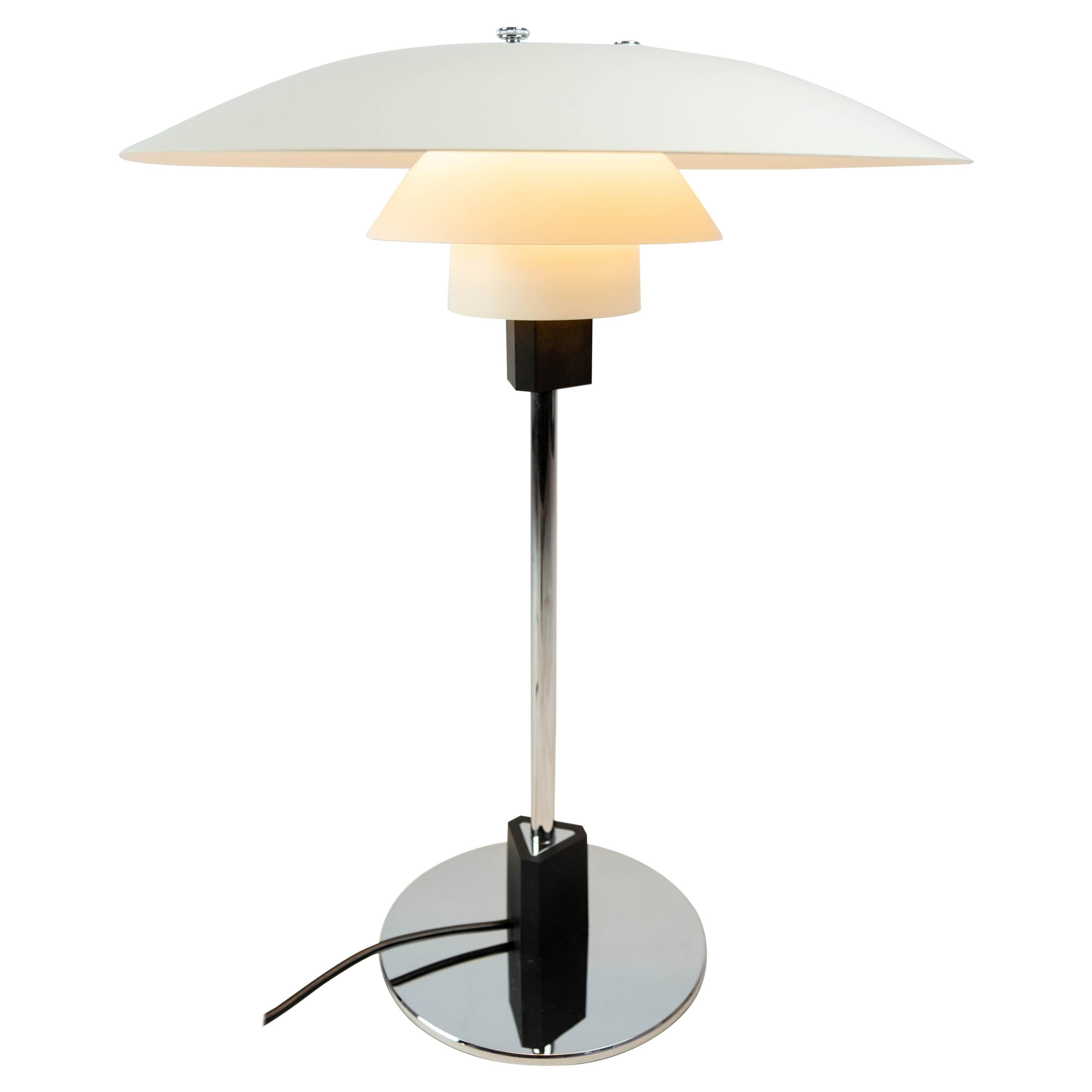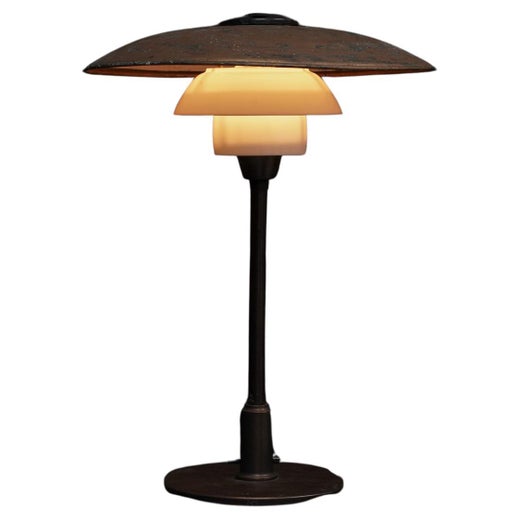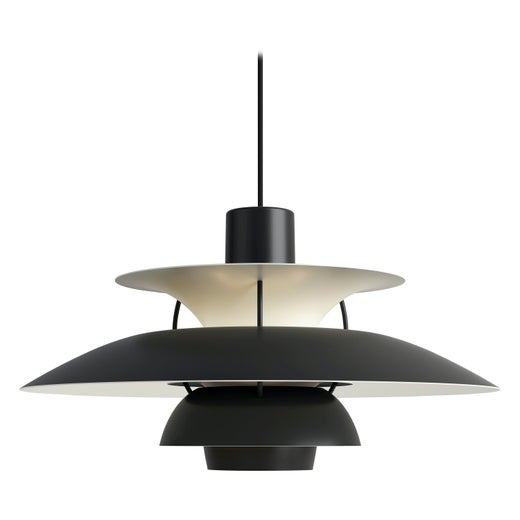Poul Henningsen Table Lamp model 3/2, 5 manufactured by Louis Poulsen 1940’s
About the Item
- Creator:Poul Henningsen (Designer),Louis Poulsen (Manufacturer)
- Dimensions:Height: 18.12 in (46 cm)Diameter: 13 in (33 cm)
- Power Source:Plug-in
- Voltage:220-240v
- Lampshade:Included
- Style:Scandinavian Modern (Of the Period)
- Materials and Techniques:
- Place of Origin:
- Period:
- Date of Manufacture:1940’s
- Condition:Rewired: Rewired by a professional electrician. Wear consistent with age and use. Minor fading. Wear of paint on the base. Minor dents on the top shade which aren’t noticeable.
- Seller Location:Valby, DK
- Reference Number:1stDibs: LU6559234980162
Poul Henningsen
The name Poul Henningsen is synonymous with the best and most innovative modern Scandinavian lamps and other lighting. The Danish designer created a signature vocabulary of fixtures with tiered and layered shades in sculptural arrangements that are at once naturalistic and geometric.
Henningsen grew up in a town on the outskirts of Copenhagen and studied architecture at the Technical University of Denmark. He would become a noted art critic, journalist and screenwriter, but his first love was lighting design.
Henningsen’s childhood home was illuminated by oil lamps. When his family switched to electrified lighting, he was alarmed and repelled by the harsh glare cast by an incandescent bulb, and in his late teens he began conducting quasi-scientific experiments to measure which materials and methods best diffused or reflected light to give it a warm brightness. His work came to the attention of the lighting-fixtures firm Louis Poulsen, which sponsored the development of a prototype lamp. The design won a gold medal at the 1925 Paris Expositions Internationales des Arts Decóratifs et Industriels Modernes — from which the term Art Deco derives. The lamp, whose three-part shade is said to be inspired by the arrangement of a dinner plate atop a soup bowl atop a teacup, became the basis for Henningsen’s most successful design, the PH 4/3 desk lamp.
All told, Henningsen would design some 100 lighting fixtures in his career. Some of his most notable creations are hanging lamps, which include the Septima (1929), a pendant composed of seven graduated frosted-glass layers; the Spiral (1942), made of a single ribbon of enameled aluminum; and the Artichoke lamp (1958), whose 70 glass or metal fins in a staggered and graduated arrangement on a central steel frame resemble those of its namesake. The last is likely Henningsen’s masterwork and an icon of mid-20th-century design. Like all Henningsen lighting designs, it is striking, sculptural and — thanks to his insistence on the primacy of the quality of the light cast — superbly functional.
Find a collection of authentic Poul Henningsen table lamps, floor lamps and other lighting on 1stDibs.
Louis Poulsen
Louis Poulsen is world-renowned as an innovator in modern Danish lighting, but this wasn’t the goal from the start. Founded in 1874 by Ludvig R. Poulsen as a wine importer, the business went through several incarnations before its first pendant lights came to fruition. Through its designs, the company helped establish the foundations of good lighting — function, comfort and ambience — that are now standard in modern furniture design.
In 1924, Danish architect Poul Henningsen partnered with Louis Poulsen & Co., then an electrical supply company, to create what’s now known as the Paris lamp. This design, which incorporated three layers of curved metal disks, created ambience with its indirect light instead of glare. Shown at the 1925 Exposition Internationale des Arts Décoratifs et Industriels Modernes in Paris — the exhibition that brought Art Deco design to worldwide attention — the Paris lamp was awarded a gold medal. This led to Poulsen and Henningsen working together on several lighting pieces, including the popular PH pendant light with its concentric shades for the Forum Building in Copenhagen. These high-profile projects helped make Louis Poulsen a go-to purveyor of innovative lighting design.
One of the company’s most well-known lamps is Henningsen’s PH Artichoke lamp (1958), with its 72 copper leaves artfully placed to conceal the light bulb, prevent glare and promote a warm, alluring glow in any room. Another is the steel and die-cast zinc AJ lamp (1960), which Arne Jacobsen designed with an adjustable angled shade for his commission for the SAS Royal Hotel in Copenhagen. The company has also worked with notables such as Verner Panton and Alfred Homann as well as, more recently, Louise Campbell and Oki Sato.
In 2010, the company was awarded the American Institute of Architects’ Honors in Collaborative Achievement Award; it was the first lighting manufacturer to receive this honor. In 2018, the company was acquired by an investment subsidiary of Investindustrial VI L.P. Still headquartered in Denmark, the brand continues to produce its high-end lighting for both indoor and outdoor use, manufacturing both classic icons as well as new designs. “We design to shape light,” states Louis Poulsen. In doing so, they have also shaped culture.
Find a range of new and vintage Louis Poulsen floor lamps, table lamps and other lighting and furniture on 1stDibs.
- ShippingRetrieving quote...Ships From: Valby, Denmark
- Return PolicyA return for this item may be initiated within 2 days of delivery.
- Just Andersen Art Deco Disko Metal Table Lamp Model D8, Denmark 1920’sBy Just AndersenLocated in Valby, 84Rare and tall Just Andersen Disko metal table lamp, Model D8. Standing at an impressive height of 72 cm (without the shade), this lamp is a testament to the elegance and sophisticati...Category
Vintage 1920s Danish Scandinavian Modern Table Lamps
MaterialsMetal
- Danish ceramic table lamp by AxellaBy Axella StentøjLocated in Valby, 84Danish ceramic table lamp from the 1970’s by danish ceramic manufacturer Axella. The lamp is in good working condition with a beautiful glaze in the bottom and an unglazed top which...Category
Vintage 1970s Danish Scandinavian Modern Table Lamps
MaterialsCeramic
- Kähler Table Lamp, Denmark, 1960sBy Kähler, Kähler KeramikLocated in Valby, 84Rare oval shaped Kähler ceramic table lamp with the Classic blue Kähler glaze from Denmark in the 1960s. Kähler Keramik is a Danish ceramic company, ...Category
Vintage 1960s Danish Scandinavian Modern Table Lamps
MaterialsCeramic
- Gunnar Nylund ceramic table lampBy Rörstrand, Gunnar NylundLocated in Valby, 84Rare Gunnar Nylund ceramic table lamp made at the Rörstrand studio in Sweden in the 1950’s. The lamp is in good condition with a beautiful glaze which gives a great structure and de...Category
Vintage 1950s Swedish Scandinavian Modern Table Lamps
MaterialsCeramic
- Big Terracotta Table lamp 1970’sLocated in Valby, 84Rare Big Terracotta Table lamp with a beautiful mixture of the unglazed terracotta surface and the white glazed texture. This vase is made by a unknown manufacturer in Europe in the...Category
Vintage 1970s Scandinavian Scandinavian Modern Table Lamps
MaterialsTerracotta
- Søholm ceramic table lamp, Denmark 1970’sBy Søholm StentøjLocated in Valby, 84Decorative Søholm table lamp manufactured in the little Danish island of Bornholm located between Denmark and Sweden. The lamp is partly glazed and other parts of the lamp are unglaz...Category
Vintage 1970s Danish Scandinavian Modern Table Lamps
MaterialsCeramic
- Table lamp, Designed By Poul Henningsen, Model 3/2, Made By Louis PoulsenBy Poul Henningsen, Louis PoulsenLocated in Lejre, DKExperience the timeless elegance of Poul Henningsen's iconic design with this table lamp, model 3/2, in black metallized design, manufactured by Louis Poulsen. This lamp is not just ...Category
Early 2000s Danish Mid-Century Modern Table Lamps
MaterialsMetal
- Vintage Table Lamp Brass "PH-Lamp" by PH / Poul Henningsen, Louis Poulsen, 1940sBy Louis Poulsen, Poul HenningsenLocated in Odense, DKStunning original production PH-table lamp model "3,5/2" by Poul Henningsen manufactured at Louis Poulsen, Copenhagen in the 1940s. The lamp base is made from patinated brass and white bakelite parts. The shades are all original and unrestored. The upper shade is made from yellow lacquered metal with a wonderful patina while the middle and lower are made from frosted matte glass which gives a wonderful light distribution. A beautiful and rare example of the world famous lamp icon. Poul Henningsen designed the three-shade system back in 1925-1926. The first lights using the system were designed by PH in cooperation with Louis Poulsen for an exhibition in Paris. PH sought to create glare-free light, direct light where it was most needed, and create soft shadows, using incandescent bulbs as a light source. PH 3/2 Table is a member of the three-shade family. Thus PH did not just design a light, but an entire system – around a thousand different models have been produced over the years. PH was the first person to pursue a scientific approach to light and use the logarithmic spiral as a basis. By using a design based on the logarithmic spiral he achieved even distribution of light over the entire curve of the shade. This even light distribution, together with the diffuse reflection through the glass, made it possible to control glare and shadow. Each shade reduces the amount of light equally, due to their distance from the light source. The PH light model numbers refer to the shade size. Each top shade had a corresponding set of middle and lower shades. In the ‘pure’ models, such as the 2/2, the top shade has a size of about 20 cm, with corresponding lower shades. PH 3/2 Table consists of an app. 30 cm top shade, but uses lower shades from the 2/2 model. These ‘hybrid’ models were introduced due to the desire to hang the pendants at lower heights. The system was also used for wall, table and floor lamps. This specific example has a "3,5" top shade (33,7 cm.) and a "2" middle and lower shade making it a "3,5/2 PH lamp".Category
Vintage 1940s Danish Scandinavian Modern Table Lamps
MaterialsBrass
- Louis Poulsen PH 3/2 Table Lamp by Poul HenningsenBy Louis Poulsen, Poul HenningsenLocated in New York, NYAbout This Product Poul Henningsen designed the three-shade system during 1925/1926. The first lights using the system were designed for an exhibition in Paris. His work with Louis P...Category
21st Century and Contemporary Danish Modern Table Lamps
MaterialsMetal
- Poul Henningsen PH 4/3 Table Lamp for Louis PoulsenBy Poul Henningsen, Louis PoulsenLocated in Glendale, CAPoul Henningsen PH 4/3 table lamp for Louis Poulsen. Poul Henningsen’s legendary design stems from his own, brilliant three-shade system from late 1920s. Poul Henningsen design fr...Category
21st Century and Contemporary Danish Scandinavian Modern Table Lamps
MaterialsChrome, Aluminum, Metal
- Scandinavian Modern PH 4/3 Table Lamp by Poul Henningsen & Louis PoulsenBy Poul Henningsen, Louis PoulsenLocated in Lejre, DKPH 4/3 table lamp designed by Poul Henningsen and manufactured by Louis Poulsen. The lamp is with white laqcuered metal shades. This product will be inspected thoroughly at our prof...Category
Vintage 1930s Danish Scandinavian Modern Table Lamps
MaterialsMetal
- Poul Henningsen Table Lamp Model Ph-2/2 'Vintergækken' by Louis PoulsenBy Poul HenningsenLocated in Limhamn, Skåne länRare and early table lamp model PH-2/2 ‘Vintergækken’ designed by Poul Henningsen. Produced by Louis Poulsen in Denmark.Category
Vintage 1930s Danish Scandinavian Modern Table Lamps
MaterialsBrass
